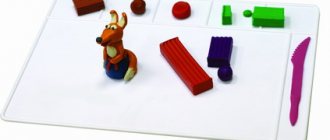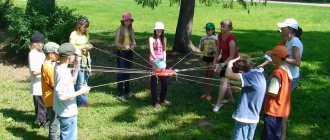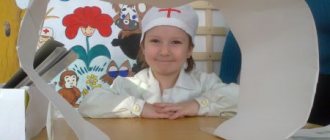“Games with rules - types, features of use in a group”
Traditionally, a game with rules appears in modern domestic pedagogy as a kind of antagonist of a plot game. Most practical teachers quite rightly believe that story-based play, or as it is often called, creative play, can take the form of a child’s free and independent activity. Another thing is playing with rules. This type of play is presented either as an ordered motor activity organized by an adult, during which children do not simply move randomly, but obey rules, the implementation of which is monitored by the teacher. Another popular form of games with rules in kindergarten is children playing with printed board games, such as dominoes, lotto and “goose”. In all of these games, the main attention of all participants, children and adults, is paid to the content of the game, its plot basis.
Games with rules represent a very extensive layer of activity for a preschool child. It is generally accepted that play with rules is of great importance for the physical, sensory and mental development of children. But, as a number of modern scientists note, the main developmental significance of a game with rules is associated with its specific characteristics. First of all, this is the development of independent normative regulation of behavior in children. If there is a rule (norm) that is mandatory for all participants, there is a need to monitor their implementation. In children, in their independent activities, conditions are created and the need arises for the implementation of such an important moral principle as justice.
A game with rules is characterized by competitive relationships between participants. The child has the opportunity to independently distinguish himself from other children, in accordance with simple and understandable criteria. For the development of a child, the fact of not only winning, but also losing is important. The experience of failure in a game contributes to the emergence in the child’s character of very important qualities (perseverance, the ability to achieve a given task, etc.), which will be useful to him in later life.
The whole life of a preschooler is connected with play. Mastering the things around him, relationships between people, understanding the meanings that social life carries, the work and responsibilities of adults - he gets acquainted with all this while playing, imagining himself in the role of mom, dad, and so on.
During the preschool period, the basic volitional qualities of the individual begin to form: perseverance and perseverance, determination, quick decision-making and bold implementation of them; self-control, that is, lack of vehemence when a conflict arises, independence, responsibility and discipline. Preschool age is a unique period in a child’s life, in which the foundations of personality are laid, the arbitrariness of mental processes is developed, creativity, activity and initiative develop. All these important qualities are formed in the process of carrying out the preschooler’s leading activity - in play. The most important role in the development of older preschoolers is played by those qualities and mental processes that are associated with the child’s ability to carry out complex, detailed play activities, primarily role-playing games with a plot, with the distribution of roles and rules. One of these qualities is will. Features of the development of will in preschool childhood are: the formation of goal setting, the emergence of struggle and subordination of motives, the emergence of internal control in behavior, the development of the ability to exert volition, speech planning of activities, encouraging adults and peers to carry out their own plans, arbitrariness in the sphere of movements, actions, and also cognitive processes and communication with adults.
Play is a creative process
According to A. Maslow, primary creativity is based on the unknowable; it can always be observed in a healthy child. This creativity is characteristic of those who can play, dream, laugh and be lazy, who can be spontaneously open to unconscious desires and impulses.
Intuition is “like a voice from heaven,” “the lord of revelation,” a new structure. This miraculous clarification, enlightenment, is a mechanism of intuition and is called insight, which translated from English and German (this term was introduced within the framework of Genetic Psychology) directly means perception.
Insight as a moment of remembrance can be seen in almost every narrative game, when it comes to finding substitute objects, actors for certain roles, integrating new circumstances into the plot, and the appearance of obstacles.
A game action is not born from an imaginary situation, but on the contrary, an operation with an action causes a game situation. Thus, the condition of play action contributes to the development of imagination and makes it necessary.
While the child is not playing, he does not imagine the game situation, and his imagination does not work.
Only during the game does the object seem to dissolve in its real properties and game meaning. Bisociation becomes the mechanism of imagination.
The term “bisociation” comes from A. Koestler, a researcher of the creative process who turned his attention to the subconscious. He emphasized the role of chance, the need to delay making decisions and think about the little things.
In the consciousness of being, as Freud said, “THE ONE,” there are no typical opposites, good and bad, right and wrong.
In this sphere of the psyche, opposites, right and wrong, are perceived as united, general, widespread.
This value-neutral perception promotes a new creative view of the world.
There are many known “techniques” of imagination. Among them is a combination of known elements in new combinations, which can be constantly observed in children's games.
It is also necessary to mention accentuation - emphasizing certain features of appearance (which is revealed). Exaggeration or arrogant understatement helps a child in a game or fairy tale to emphasize the game in some - or subjectively very important - sense. An accentuated reflection of a specific character or situation contributes to generalization and typification, since some features are simplified, discarded, and random features are discarded.
A child’s play activity is always of a generalized nature, since the motive is not determined by a specific phenomenon, but by the action itself, as a personal relationship.
In play, the child does not inherit or convey any specific characteristic traits; he is always typified.
Intuition stimulates the imagination, and the imagination perceives the development of creative thought.
Every active person has an ineradicable need to move from sensory perception of the world to rational thinking, the mechanism of which is mediation.
Thinking is the process of indirect cognition of things and phenomena, understanding the relationships and connections between them.
In all sensory phenomena, the child makes every effort to find the corresponding meaning, and his endless “how? Why? For what?" aimed at revealing the secrets of its existence.
New things that appear before a child every day are a mystery to him.
Thinking becomes a generalization of the result of observation, a generalization of indicative activity.
A person will not calm down until a mysterious, unknown phenomenon, disturbing by its very existence, acquires a certain meaning, which appears at the beginning of the game.
Play concentrates all developmental tendencies; through play, the child rises, as it were, above the ordinary level of his thinking and behavior.
Bonus: what to do if you are tired of all the games for a long time
New Year's Eve is the time to try something new and even magical! For example, to be in virtual reality. Look where they rent VR equipment in your city, it could be a website or an individual on Avito. Prices depend on the configuration and start from 3,000 ₽ per day, plus, most likely, they will ask for a deposit of about 20,000 ₽. To play you will need:
- space in the room - at least 2x2 meters;
- a computer - you can also rent it, and it’s even easier to connect VR, because everything is already configured on it - or a game console, for example PlayStation;
- VR equipment itself, in particular a helmet or glasses, controllers, base stations.
When renting, it is better to draw up an equipment acceptance certificate and stipulate in the contract the rental price and the return period for the kit.
When writing this article, Sravni.ru did not collaborate with stores or game manufacturers. Prices are current as of December 23, 2022 and are subject to change. Prices and photographs are taken from the Yandex.Market website.
Free games for the New Year
If you didn’t have time to buy a game or don’t want to spend extra money, you can play free games. Here are some options.
"I never"
Each person in turn must continue the phrase “I have never...”. For example, the first player says: “I’ve never received a tax deduction” (although obviously you can come up with something more interesting!). If anyone present has received a tax deduction, he must bend his finger. Then the second player says his phrase - and so on in a circle. The one who bends all 10 fingers is out of the game. The main thing is honesty!
The game can be adapted for the New Year. For example, the first round, until everyone leaves the game, is carried out in the usual way. And dedicate the second game to 2022 and say: “In 2022, I never... (cooked okroshka).” The one who prepared the okroshka bends his finger.
"Mafia"
“Mafia” is good because you can draw the cards yourself by cutting A4 sheet or cardboard. You need to find the rules on the Internet and draw as many cards as there are people at the table. For example, there are six people at a table. We draw 6 cards: on one we write “Leader”, on the second and third - “Mafia”, on the fourth - “Doctor”, on the other two - “Peaceful Resident”. You can add another civilian instead of the second mafia, then the civilians will have more chances.
The rules are simple: the host says “The city is sleeping” and everyone closes their eyes. The presenter says: “The mafia is waking up.” Two mafias (or one, or three) open their eyes and quietly point a finger at the person they are “killing.” The presenter orders the mafia to fall asleep and says: “The doctor wakes up, the doctor chooses who he will treat.” The Doctor points to the man he thinks was killed by the mafia (you can point to yourself a maximum of two times in a row). Then the presenter orders the doctor to fall asleep and wake up the whole city. And if the doctor cured the wrong person, then the presenter says who became a victim of the mafia. Then the entire city, except for the “dead”, must discuss what happened at night and vote against the person whom he considers to be the mafia. Based on the results of the vote, this person leaves the city. He can show everyone his card or not - this must be agreed upon at the beginning of the game. It is easier for civilians to win if the eliminated and “dead” show their cards.
"Drawings on the back"
Several people (up to five) line up one after another in a train. Each person is given a piece of paper and a marker. The first person places the sheet on the back of the person in front and begins to draw a figure step by step or immediately. The next one must understand what kind of figure is drawn and redraw it on the sheet on the back of the third player. For example, if the first one came up with a snowman, then first he can draw the bottom circle, then wait until the other players redraw it. Then draw the middle one and so on until the end. But you can draw a snowman at once - try both options and decide with your friends which one is more interesting for you.
"Drawings with closed eyes"
A game similar to the previous one, but no longer a team game. The first player thinks of a word for the second (the main thing is simple!), and he draws this word with his eyes closed. Whoever guesses first what is drawn, the second player guesses his word.
"Crocodile"
It's almost the same as "Equivocals" or "Charades", only for free. The first player comes up with a word and tells it to the second player, who gestures it to the others. Whoever guessed the word, the second player guesses the next one.
Advice
For games with words, there are free mobile applications with collections of words that can be explained in words, gestures or drawings. For example, the “BOOM” (Android/iOS) or Alias (Android/iOS) applications.
"Beer Pong"
To play, you will need a clean table, identical cups (for example, disposable ones) and a table tennis ball. You need to pour water (or any other drink) into glasses and arrange them into two equilateral triangles, one of the vertices of each pointing towards the center of the table. Then everyone is divided into two teams, and each player takes turns throwing the ball into any glass at the other end of the table. The player gets one point if he hits the glass.
In the original rules of the game, if a person hits the glass, he must drink the drink. But this is not very hygienic (the ball constantly falls on the floor and then into the glass) - instead, you can, for example, take a sip from your own drink. You can also put a piece of paper under each glass with a task or question - for example, about the outgoing year 2022 or about plans for 2022. If you are reluctant to prepare these tasks, set the following rules: the person who gets into the glass must either thank the past year (or the people around) for something specific, or talk about something from their plans for 2022.









